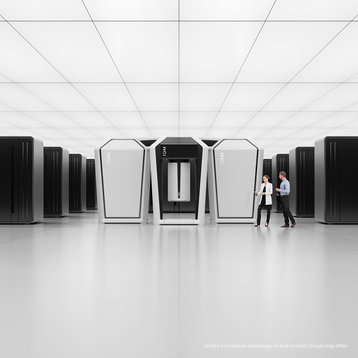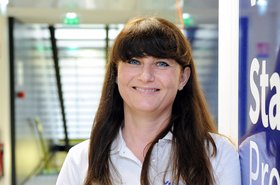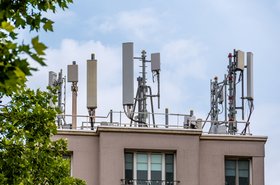As you step into a quantum data center, the first thing that surprises you is the noise.
The constant hum of fans you might be used to in a traditional server room is still there, but much quieter. Above the constant hum is the regular pumping of compressors forcing super-cooled liquids into the system to ensure atoms on chips maintain their quantum state. It’s a sound that feels closer to pistons of a steam engine than electronics at the bleeding edge of computational physics.
Quantum computers might still be in their nascent stage, but even today’s early-stage systems are being deployed in increasingly large numbers in a growing variety of locations. But what does a quantum data center look like, and how does it compare with what we know of data centers today?
DCD visited quantum data centers operated by IBM and IQM in Germany to see these systems out in the wild.
What does a quantum data center look like?
Much like the growing number of AI-polluted pictures of futuristic data centers you see online, the term quantum data center suggests something sleek, shiny, and perhaps slightly alien to what we’re used to seeing. The reality, however, is less flashy.
Though first announced in mid-2023 and opened in October 2024, IBM’s ‘quantum’ data center in Ehningen, just outside Stuttgart, actually dates back to the 1970s; fittingly, a time when science fiction was decidedly more tactile in aesthetic. IBM has been present in Ehningen for close to 100 years, and the company is amid an update of its presence at the site, exiting some older office buildings and developing new ones.
The building that hosts Big Blue’s quantum systems previously housed client systems for what we might now consider private cloud deployments, long before the term was coined. Today, the basement continues to host traditional IT systems for IBM’s own R&D teams, with the data hall featuring the company’s quantum systems on the ground floor. The Ehningen site has actually been hosting a quantum system since 2021.
“It’s used as a data center for our research and development teams, not primarily quantum, but also the other business units,” says David Faller, IBM vice president of development, and managing director for IBM Germany Research and Development. “It was a very, very good match.”
IBM showed DCD around the quantum experience center in the facility, which included an IBM System One, hosted in an impressively sleek glass cube. At the time of our visit, the data center was home to two System Ones, each powered by IBM’s 127-qubit Eagle quantum processing unit (QPU).
“We did the agreement with [research organization] Fraunhofer to set up the Quantum System One in 2021,” says Faller. “The team in Yorktown [IBM’s research center in New York, US] were the only ones that really worked on building quantum computers. They packaged all the boxes and sent them over here with the intent that when the boxes arrived a couple of weeks later, they would hop on a plane and get there and assemble that system. But then the Covid-19 lockdown came.”
Luckily, the IBM research and development team right next door had “decades-long experience in mainframe technology, down to designing and validating the processors in our IBM Z Systems, the cooling technology, the system packaging, all these elements,” Faller says. He continues: “We recruited people from that team who know about cooling technologies and control electronics and trained them up with video conferences all day long with the US team.”
The company didn’t share precise specifications of the data center, nor how many quantum computers the facility could host. DCD is told, however, the classical IT in the basement data hall takes up “much more” power than the quantum floor; space and power is unlikely to be an issue at the site.
“There’s definitely the intent to grow,” Faller says. “If we have the demand over the next years, we can decide about taking other space and turn it into more quantum data center space.
“At the moment, we’re using the upper floor for office space, and the quantum team has offices here as well to be close to the systems.”
Despite the need to host liquid helium and nitrogen – with the helium pipes going under the raised floor – as well as accommodate taller systems than your typical racks, Faller says the site is “regular data center space.”
“For a reasonably modern data center, I don’t think you have to do much,” he says.
The German data center of IQM, a Finnish quantum computing company spun out of Aalto University and VTT Technical Research Centre of Finland in 2018, is also not the futuristic shell ChatGPT might suggest a quantum facility might be, but a run-of-the-mill office building in Munich.
Launched in June 2024, the company is leasing space at Georg-Brauchle-Ring 23-25, a former Telefonica office building. Acquired and redeveloped by Bayern Projekt and Europa Capital in 2017, the 39,000 sqm (420,000 sq ft) complex was rebranded as the Olympia Business Center and sold to family office Anthos in 2022.
With Telefónica consolidating to the 37-story O2 Tower further down the street, the office complex is home to a number of companies; IQM’s staff occupy space in the upstairs of the building, while the quantum data center resides in the basement, in white space previously used by O2. Housing two IQM quantum machines at launch, the data center is able to host up to 12 quantum computers, totaling 800kW of power capacity.
Jan Goetz, IQM co-CEO and cofounder, is German and did his doctorate on superconducting quantum circuits at TU Munich before moving to Aalto University in Finland. The company had long had a team in Munich, but decided to launch a quantum cloud-focused facility in the city.
“The goal here is really to separate the R&D and production,” Goetz tells DCD at our visit to his facility. “So here in Munich, these systems should really be production systems, meaning high online availability; whereas the systems that we’re running in Finland are mainly R&D systems, with our own engineers having access and trying out things.”
He said the site combined a data center and office, which suited the company. There was little needed in the way of power and cooling, due to the relatively low power needs of quantum systems. Most quantum machines measure in the tens of kilowatts.
“It wasn’t a challenge here, and this is not a challenge in general for deploying quantum computers,” says Goetz. “The only real change on the building side was we had to open up a little bit the entrance, because they’re a bit bigger than the typical server rack that you have.”
While Goetz seems keen to say the data center is pretty standard overall, a visit to the data floor reveals some usual characteristics. The center of the square hall features what Goetz describes as a ‘separated service area’ – essentially a room within the room – to host the compressors, pumps, and storage for the liquid nitrogen and helium.
Each quantum system and the single accompanying rack of microwave signalling and processing equipment is placed out in the main white space area on either side of the service area in a sort of horseshoe layout.
With only half a dozen 20-qubit quantum systems installed at the time of DCD’s visit, meaning only six regular air-cooled racks on the main floor, the data hall is relatively quiet and pleasant compared to some spaces. The regular pumping of compressors is the most notable – and unusual – part of the experience.
Unlike a traditional data center, Goetz says the company’s data hall doesn’t have a required optimal temperature to run at – the cryostats regulate themselves and signaling equipment doesn’t run at high densities – but a constant temperature is more important: “We want to have a stable temperature,” he says. “We don’t want variations because it might affect the length of the cables if the temperature drifts too much.”
Quantum form factors changing
Both IBM and IQM’s systems use superconducting-based technology. These systems feature the iconic chandelier design, with the quantum chip sat within dilution refrigerators, large cryogenic cooling units that use helium-3 in closed-loop systems to supercool the entire system.
While most press pictures of IBM’s quantum computers show a system hosted within a great glass cube, behind the curtain, the company operates a greater number of less presentation-worthy systems.
First revealed in 2019, the nine-foot sealed cube, made of half-inch-thick borosilicate glass, is an impressive self-contained unit – with much of the cooling infrastructure hidden in the top and control systems behind.
The company has deployed such cubes in a number of locations for customers; Cleveland Clinic deployed such a system at its HQ in Cleveland, Ohio, instead of the company’s data center on the edge of the city, while the Rensselaer Polytechnic Institute in New York also gave its own quantum system a pride-of-place display in a former chapel now housing its computing center.
Behind the scenes, however, most IBM-hosted quantum computers are less flashy and more functional for traditional white space. A simple metal frame holds a supercooled cryostat, with a traditional 19-inch rack next to it holding all the accompanying control and signalling equipment.
But while many quantum companies are seeking to fit their quantum processing units (QPUs) into standard racks, IBM is pushing a new form factor that could offer more powerful systems at the cost of form factor.
IBM’s System One quantum computers currently feature one QPU within one cryostat – a supercooled fridge hosting the golden chandelier commonly seen when talking about quantum computing.
IBM has since launched its System Two, a much larger system that comprises three QPUs in three cryostats hosted within one large hexagonal system.
As well as hosting three cryostats (each hosting one QPU) in one large shell, IBM has designed the system to be modular in terms of what can connect to it. While one side of the hexagon could host the control and signalling equipment, another side could feature racks of CPU or QPUs to create a hybrid system, or even more QPUs in a separate System Two hexagon.
“The System Two is the stage to be so modular that we really can build quantum computers that, in future, will bring us the quantum advantage,” says IBM’s Faller. “Our plan is, in the next few years, that you can connect up to seven into one virtual quantum computer so you end up with more than 1,000 qubits that you can use for your algorithms. That trio of traditional IT, GPU, and quantum processor units is something that we are anticipating for our IT solutions going forward. ”
A System Two has been deployed at IBM’s quantum data center in New York; the Ehningen facility is set to have a System Two in future. A Bluefors hexagonal Kide cryogenic platform, developed in partnership with IBM, measures just under three meters in height and 2.5 meters in diameter, and the floor beneath it needs to be able to take about 7,000 kg of weight. IBM has also developed its own giant dilution refrigerator, known as Project Goldeneye, that can hold up to six individual dilution refrigerator units and weighs 6.7 metric tons.
IQM, however, is taking a different route, hoping to shrink its machines down to standard rack-based systems.
“We don’t yet have the full quantum computer in a 19-inch rack,” says IQM’s Goetz. “But we are working in this direction. So from this perspective, I don’t think that the kind of typical look and feel of the data centers changes so much.”
Goetz notes that the liquid helium for IQM’s systems is a closed-loop, and the company is working towards a quantum computer without the liquid nitrogen, meaning the system will eventually be fully closed and not require liquid refills.
“Right now, most systems still have a liquid nitrogen trap, which you need to refill,” he explains, “and you need maybe one hour of training on how to deal with the cold liquids.”
What will a quantum data center look like in the future?
Despite claims from some operators, it seems there are few purpose-built quantum data centers in the world yet – aside from the UK government’s National Quantum Computing Centre (NQCC) building at the Harwell Science and Innovation Campus in Oxfordshire.
As far as DCD is aware, every other space dedicated to hosting quantum computers is within an existing data center or lab, or a converted industrial building tailored to feature some white space.
That’s not to say there won’t be more dedicated, purpose-built quantum data centers in future. And work to ensure they are standardized is already underway.
At its EMEA summit in Dublin in April 2025, officials from the Open Compute Project said they were looking to work with quantum computing companies and the operators that might such systems to develop standards around quantum computers.
Cliff Grossner, OCP chief innovation officer, said the standards group hopes to develop an OCP quantum-ready certification in the near future.
The group’s existing self-assessment OCP-Ready program helps operators show their data centers meet the best practices and requirements defined by hyperscalers such as Meta and Microsoft, and are ready to host OCP-compliant equipment.
Grossner said OCP hopes to have a first draft of what a quantum-focused certification might look like out sometime in 2026; “It’s better to think about it now; I believe we have enough to make a good start,” he said in Dublin, noting some preliminary work with Orca and IQM had gone on during the conference.
Quantum-focused measures that might need to be considered include vibrations, electromagnetic sensitivity, and potentially even the speed of the elevators moving hardware between floors. Whether or not there would be one standard encompassing the different types of quantum computers – supercooled, rack-based, optical-tabled etc – or multiple standards to suit all comers is unclear at this stage.
The geography of sovereign quantum
While its becoming increasingly common to see quantum computing systems in supercomputing centers, its still rare to see QPUs outside spaces hosted by quantum computing companies.
UK quantum computing firm Oxford Quantum Computing (OQC) has deployed six of its QPU systems in two colocation data centers: Centersquare’s LHR3 facility in Reading, UK, and Equinix’s TY11 facility in Tokyo, Japan. OVH has a system from Quandela at one of its facilities in Croix, France. Fridge supplier Oxford Instruments has installed a Rigetti quantum computer at its main factory site in Tubney Wood, Oxfordshire.
IBM does also host some dedicated quantum systems at its facilities for customers who don’t want their QPUs on-site, but on-premise enterprise deployments are rare beyond the likes of IBM’s agreement with Cleveland Clinic.
They will likely be the exception rather than the norm for enterprises for some time to come, IQM’s Goetz says.
“Corporate enterprise customers are not yet buying full systems,” says Goetz. “They are usually accessing the systems through the cloud because they are still ramping up their internal capabilities with the goal to be ready once the quantum computers really have the full commercial value.”
Quite what the geography of a world with commercially-useful quantum computers will look like is unclear.
Will enterprises be happy with a few centralized ‘quantum cloud’ regions, demand in-country capacity in multiple jurisdictions, or go so far as demanding systems be placed in on-premise or colocated facilities?
“We think enterprise customers will start buying systems – larger customers that have their own computing centers or in colocation data centers,” Goetz suggests. “And there will also always be some business that goes through the cloud.”
IQM expanded into Germany, Goetz says, due to the strong quantum R&D ecosystem fuelled by the city’s university talent, combined with lots of local industry. The CEO thinks Munich should also serve as a template for data centers the company hopes could be deployed globally should sovereignty become more of an issue.
“Sometimes it helps if you have the computer physically in a certain jurisdiction,” he tells DCD. “If you are dealing with sensitive data or with government organizations, they might require that the computer is actually physically located in their country. So [Munich] can be a blueprint on how to build a data center in other places in the
future.”
What the company’s future buildout will eventually look like will depend on customer demand. Goetz says he is seeing a lot of demand, and the company is preparing to have a “good number” of cloud-based systems available. He notes that the current geopolitical situation around the world is seeing budgets growing on the defense side, which could be a “clear sign that there will be a need for sovereign quantum cloud,” likely fuelling the need for in-country quantum compute.
IBM currently operates nine multizone cloud regions, two single-campus regions, and seven single data centers within its cloud footprint. IBM’s Faller says the company is “committed” to growing its data center footprint in the US and Europe, but quite what the final picture will look like around its quantum footprint will depend on the customers.
“There is no real plan yet to have the data centers in each region,” he says, “but if the demand is there, why not?”
Faller continues: “We are convinced that this will be really a fundamental element of supercomputing in the future. That’s why we’re talking about that quantum-centric supercomputing, bringing those worlds together.”
“The hybrid model of cloud and the option on dedicated systems will make sense for quite some time. It’s the same way that we have options to put mainframes or Power servers in your own data center or via the IBM Cloud. Both models exist, and I think they will be around for a number of years to come. That will not change easily.”
If and when we reach quantum advantage isn’t clear. Some companies suggest we’re already coming against some extreme use cases where classical hardware struggles to compute a reliably accurate answer in a useful amount of time.
We are at the point where some particular workloads actually might be more efficient on quantum hardware in theory; however, even if the quantum algorithm would be more effective, the quantum hardware often isn’t currently powerful enough for a full-scale real-world deployment.
While both companies believe we’ll get there, when we reach quantum advantage isn’t so clear. IQM’s Goetz argues it will be a slow build-out over time, use case by use case, rather than one big bang.
“We might be a decade or more away from all-powerful, multi-million qubit systems delivering the ultimate quantum advantage, but Goetz notes that “doesn’t mean that there’s nothing on the way there,” in the same way the utility of GPUs has grown over time as more companies use them for AI.
Read the orginal article: https://www.datacenterdynamics.com/en/analysis/inside-a-quantum-data-center/






















